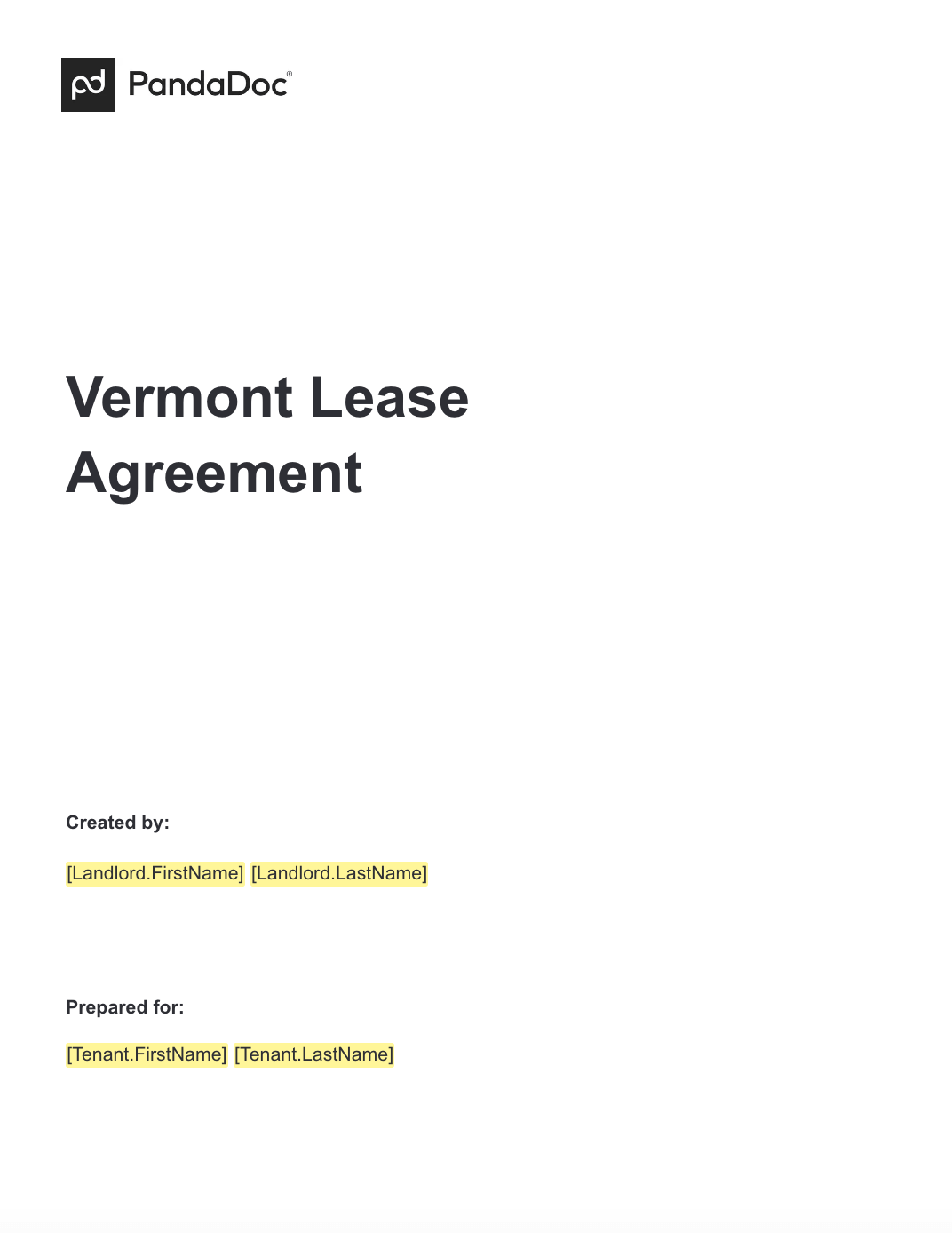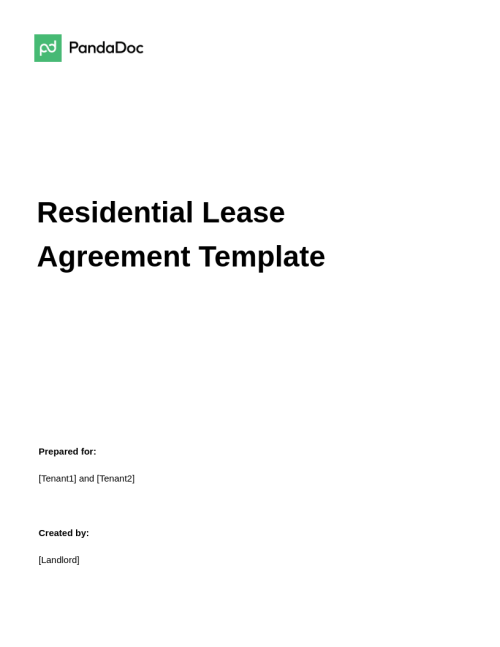Key Takeaways
- Chapter 137 – Residential Rental Agreements covers all of the details surrounding leases. It falls under Chapter 9 of the Vermont Statutes.
- The security deposit amount isn’t limited. However, lessors must return it within 14 days, or they might have to pay double the amount.
- The eviction notice periods range between 14 and 30 days, depending on the violation.
- A lessor must provide 40 to 48 hours’ notice before entering the property.
- Vermont only requires one (1) federal disclosure.
Vermont Lease Agreement Templates
Residential Lease Agreement

Residential Rental Agreement
Used 5,261 times
Save time and resources by using this customizable residential rental agreement to create legally binding contracts with your tenants. It includes detailed sections about all aspects of a typical tenancy, including terms, responsibilities, rent, duration, insurance, maintenance, and more.
Use this agreement template to establish the terms and conditions for renting a residential property in Vermont.
Vermont Apartment Lease
Tailored specifically for apartment rentals within the state, this lease agreement template comprehensively outlines the terms of tenancy, including rent, utilities, and property rules.
Vermont Room Rental
Designed to facilitate shared living arrangements within Vermont’s residential properties, this formal template establishes clear guidelines for tenants renting individual rooms.
Vermont Month-to-Month Lease
Opt for this agreement template to offer flexibility without the commitment of a long-term lease in Vermont. It allows for short-term rental arrangements while maintaining a professional and legally binding contract.
Commercial Lease Agreement
Select this agreement template for leasing commercial properties in Vermont. It addresses crucial considerations such as lease terms, rent adjustments, and more.
Lease to Purchase Agreement
This agreement template navigates the complexities of lease-to-own arrangements, ensuring stability and transparency throughout the process.
Sublease Agreement
This formal agreement template facilitates subleasing arrangements within Vermont’s rental market.
Understanding Vermont Rental Laws
Under the Vermont Statutes, Title 9: Commerce and Trade, Chapter 137: Residential Rental Agreements govern leases. We discuss the specifics of these laws in the table below before expanding on essential sections.
| Laws | Name | Description |
| Subchapter 1, Sections 4451 to 4454 | General | General provisions and definitions in relation to rental leases |
| Subchapter 2, Section 4456a | Residential rental application fees; Prohibited | The leasing process and what terms lessors can’t add to a lease. |
| Subchapter 2, Section 4456b | Subleases; Landlord and tenant rights and obligations | Tenant rights, along with an explanation of subleases and landlord obligations. |
| Subchapter 2, Section 4457;Subchapter 2, Section 4459; | Landlord obligations; Habitability; Minor defects; Repair and deduct | Terms about the landlord’s obligations towards ensuring the unit is habitable and in good condition. |
| Subchapter 2, Section 4461 | Security deposits | Details about security deposit limits, return periods, and other laws. |
| Subchapter 2, Section 4467 | Termination of tenancy; Notice | Notice periods for lease terminations and the process both parties must follow. |
| Subchapter 2, Section 4464 to 4465 | Illegal evictions; Remedies for illegal evictions | Explanation of the evictions that are illegal and what tenants can do in return. |
| Subchapter 2, Section 4460 | Access | A section detailing the landlord’s access to the property and entry notice periods. |
| Subchapter 2, Section 4455 | Tenant obligations; Payment of rent | Terms surrounding notice periods for increasing rent and a tenant’s obligation to pay rent. |
| Subchapter 3;Subchapter 4 | Farm Employee Housing; Campgrounds | These subchapters detail the different laws surrounding other lease agreement types. |
Security Deposit Limits
- Vermont doesn’t limit the amount lessors can ask for security deposits. However, most lessors ask for an amount equal to one (1) month’s rent.
- Cities and counties in Vermont can implement limits, so always keep an eye on local laws.
- While there’s no state law requiring lessors to bear interest on the security deposit, some cities might have different laws. For example, Burlington requires lessors to pay the lessee interest on the amount equal to the current interest on a bank passbook savings account.
- A lessor has 14 days from the lease’s termination to return the security deposit to the lessee. If they don’t return it in time, they can’t keep any part of the deposit.
- If lessors intentionally miss the deadline, they’re liable to pay twice the amount, along with attorneys’ costs and fees.
Eviction Procedures
- Lessors can evict lessees for specific reasons, none of which is retaliation.
- The eviction notice depends on the lessee’s violation:
- Nonpayment of rent: 14-day notice to pay rent or quit
- Violation of lease terms: 30-day unconditional quit notice
- Criminal activity or violence: 14-day unconditional quit notice
- All notices must include the termination date. Further, if the lessee doesn’t remedy the violation or leave the premises within the stated period, the lessor can file an eviction lawsuit in court.
Right to Enter (Landlord)
- Lessors must provide at least 40 to 48 hours’ notice before entering the property.
- They can only enter at reasonable hours, which is between 9 am and 9 pm, in Vermont.
- A lessor can only enter the property with reasonable cause, including:
- Inspections;
- Repairs;
- Agreed-upon Services;
- Show the property to prospective buyers, renters, or mortgagees.
- The only exception to the notice period is if the lessor has reasonable cause to believe it’s an emergency. Emergencies include if there’s imminent danger to the lessee or property.
Disclosures
Vermont, unlike many other states, doesn’t have any state-required disclosures lessors must include in the agreement. However, the federal disclosure is mandatory:
- Lead-Based Paint Disclosure: This law applies to houses built in or before 1978. It discloses the presence of lead-based paint and its hazards.



